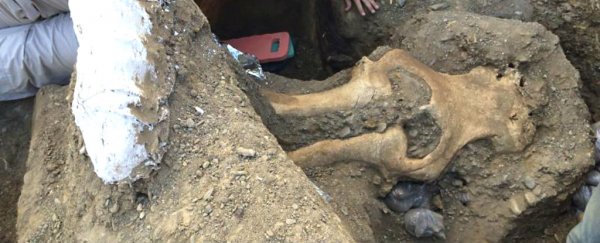An exceptionally well preserved fossil of a complete mammoth skull has been unearthed on a tiny island off the coast of California, and it's got palaeontologists rethinking how these massive animals might have lived alongside humans.
Dated to 13,000 years ago, the skull was uncovered near a stream on Santa Rosa Island - part of California's Channel Islands National Park. That date is important, because it happens to coincide with the age of the Arlington Springs Man - the oldest human skeletal remains found in North America.
"This mammoth find is extremely rare and of high scientific importance," said one of the team, Justin Wilkins, a palaeontologist from the Mammoth Site museum in South Dakota.
"It appears to have been on the Channel Islands at the nearly same time as humans," he adds. "I have seen a lot of mammoth skulls and this is one of the best preserved I have ever seen."
Based on an analysis of the skull, the team suggests that new type of mammoth could have been roaming the Channel Islands with some of its earliest human inhabitants.
The remains of the Arlington Springs Man were also discovered on Santa Rosa Island - about 42 km (26 miles) off the coast of Santa Barbara, California.
Archaeologists have placed his life at the end of the Pleistocene, when the four northern Channel Islands formed one mega-island called Santarosae.
We know from previous evidence that mammoths roamed the continent of North America approximately 2 million years ago, and a species called the Columbian mammoth (Mammuthus columbi) managed to swim to Santarosae between 20,000 and 40,000 years ago.
But this skull doesn't look like a Columbian mammoth's.
Over several thousand years, these Columbian mammoths rapidly evolved to suit their new island lifestyle, and shrunk from 4.2 metres tall to 1.8 metres, and their features became so different, a new species arose - the more diminutive pygmy mammoth (Mammuthus exilis), the smallest mammoth in the world.
But this skull doesn't look like a pygmy mammoth's either.
The team explains that the skull is not large enough to be a Columbian mammoth's, but it's not small enough to be a pygmy mammoth's. So the two most likely explanations is that this is a juvenile Columbian mammoth, or it could represent a transitional species that was partway through evolving from Columbian to pygmy.
Of course, the juvenile scenario would be a whole lot easier to explain, except for the fact that its tusks are all weird.
"The right tusk protrudes 1.4 metres (4.5 feet) in a coil characteristic of an older mammal, while the shorter, sloped left tusk is more typical of a juvenile," they explain.
Instead, this could be the first evidence that there were two sets of Columbian mammoth migrations to Santarosae.
"The discovery of this mammoth skull increases the probability that there were at least two migrations of Columbian mammoths to the island - during the most recent ice age 10 to 30,000 years ago, as well as the previous glacial period that occurred about 150,000 years ago," says one of the team, Dan Muhs, from the US Geological Survey.
It's important to note that this is pure speculation right now - the team has only done preliminary measurements and analyses on the skull, and will need to prepare their findings for peer-review in the coming months.
But this strange skull could be our first glimpse into how these incredible extinct creatures used their trunks as snorkels not once, but twice, to get a taste of that sweet, sweet island life.
